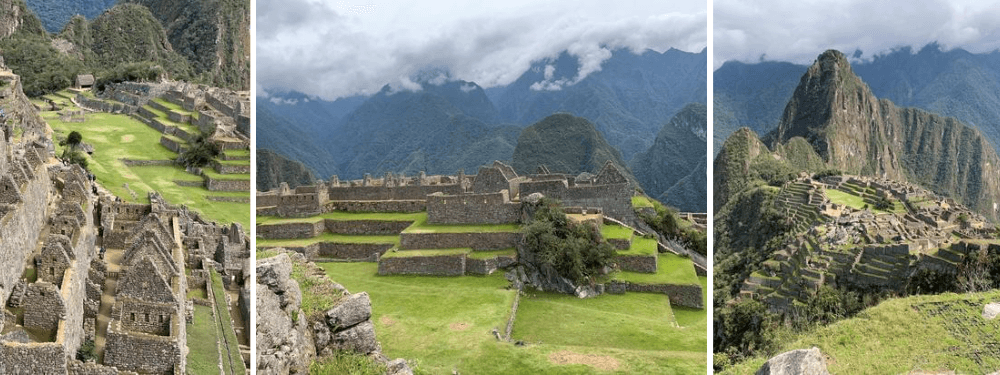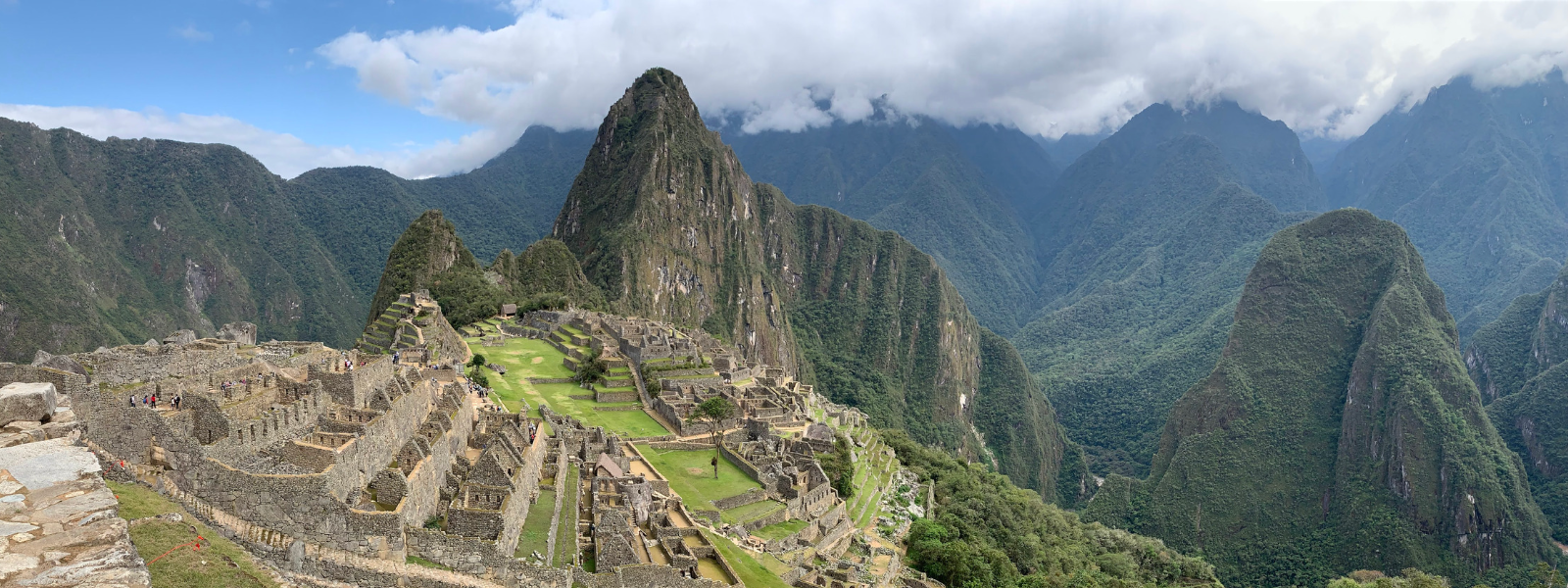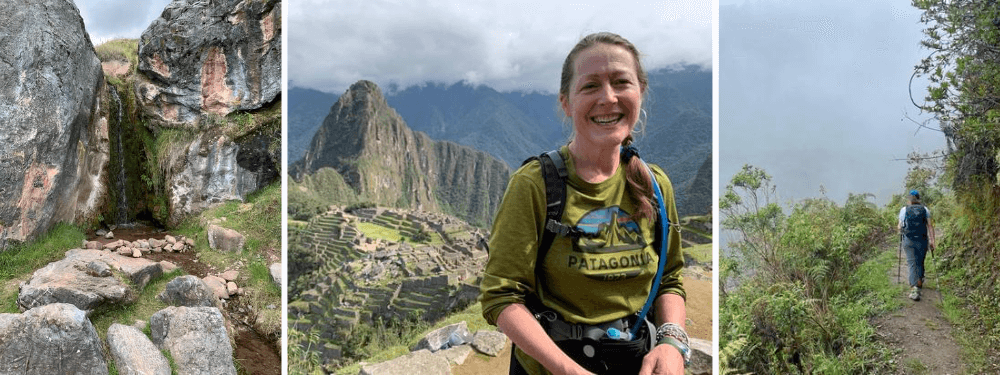
Greetings Adventures in Good Company community. After seven years of guiding and working for AGC, I’ve officially retired. I’ll continue guiding and look forward to seeing many of you on trail, but I’ve stepped away from my day-to-day job in the office and into the world of retirement. Family and friends have asked what I plan to do next, and while I do have some ideas, the honest answer is that I don’t really know. I’ve never been very good at dealing with uncertainty, so I’ve been happily surprised with how comfortable I am not knowing exactly what the future holds. I embrace the idea that things happen for a reason, opportunities arise, and that retirement will be both a journey and an adventure.
In November of 2021, AGC sent me on a trip to Machu Picchu with Mountain Lodges of Peru, our long-standing partner in the region. I participated in the same trip that AGC offers, Trekking to Machu Picchu, including a multi-day trek along the Salkantay Trail with stays in beautiful mountain lodges along the way, a visit to Machu Picchu, and tours of Cusco and the Sacred Valley. On that trip, I fell madly in love with Peru. I came back brimming with stories, pictures, and an incredible enthusiasm for the area. A short time later, as I was contemplating retirement, my partner suggested we move to the Sacred Valley of Peru for three months. Just like that, life unfolded, and my first adventure began.
The Sacred Valley is nestled in the heart of the Andes mountains, about an hour and a half from Cusco. It is a picturesque valley full of rolling hills with grazing cattle, horses and alpacas, surrounded by immense mountain peaks and glacial lakes. The spiritual and cultural aspects of the Peruvian people are manifest everywhere, from architecture inspired by celestial bodies to homespun scarves with ornate images of Peruvian folklore, and from terraced agriculture to festive Pachamanca celebrations of roasted cuy (guinea pig). On my trip last November, these aspects were most spectacularly manifest in and around the fortress of Machu Picchu.
During our three months (the longest time allowed as a tourist from the US without a visa) in this incredible place, we hope to immerse ourselves in the culture, explore more of the surrounding areas, and make lasting friendships with the neighbors. Traveling so far from home for an extended period is daunting, but therein lies the adventure!
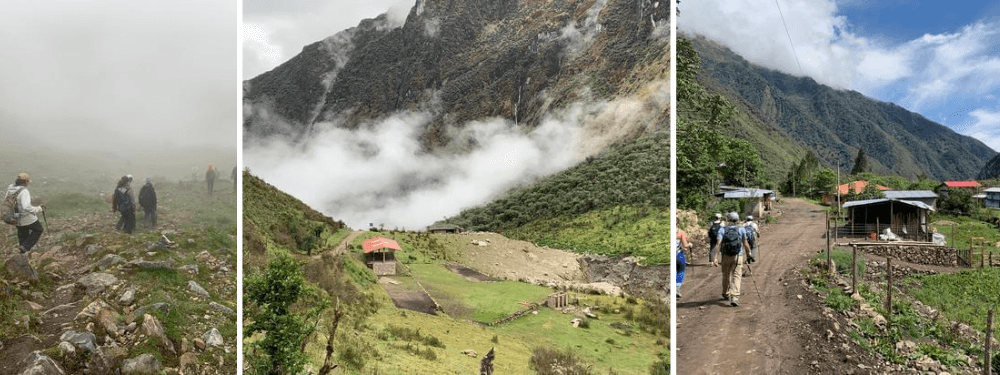
Returning to the Andes mountains and the Sacred Valley
I want to return to the ever-changing landscape of the Sacred Valley, tightly interwoven with the varied elevations. I vividly remember how the first days of our trek were spent bundled up at the foot of the Salkantay and Humantay mountains. The snow-capped peaks filled the skyline as the glacial runoff fed into the intensely blue and turquoise waters of Lake Humantay. The most predominant greenery above 14,000 feet is a variety of highland grasses, dotted with low-lying shrubs, with views of rolling valleys stretching for miles and miles.
After a day of acclimation, we struck out across the glacial moraines and summited the Salkantay Pass amid wind gusts and swirling snowflakes. Exchanging puffy coats for rain jackets, we descended quickly to cloud forests filled with moss-covered trees. Wildflowers of pale lavender, saffron yellows, and fuschia pinks slowly began appearing as we descended. Shortly thereafter, in much lighter layers, we found ourselves trekking alongside crops of squash, potatoes, and coffee beans. As we descended through these lower elevations, though still above 9,000 feet, we also began passing through more inhabited areas, sharing the same trails that have been used for generations.
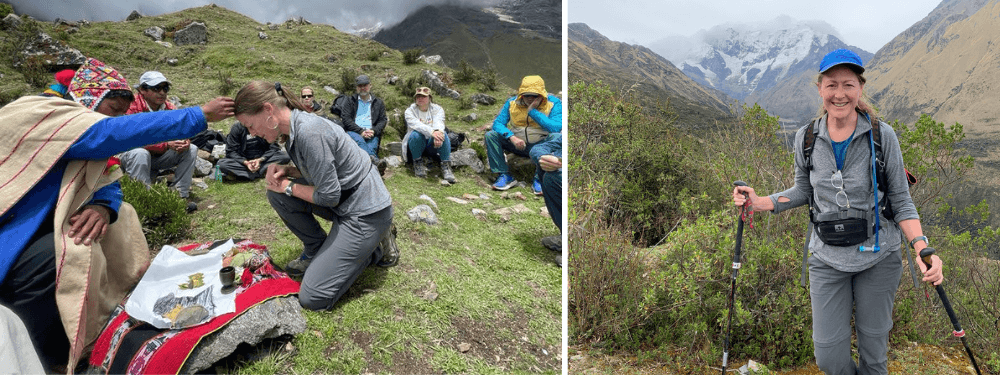
Spiritual and Cultural Heritage
Our local guides shared stories that brought to life the Chakana, a symbol representing a bridge between three worlds; the world of gods, the world of man (Earth), and the world of the dead (spirits and ancestors). It’s depicted as a stepped cross representing the cardinal points of the compass, with each side shown as a 3-stepped pyramid. The Chakana represents a significant dualism between life and death and that everything in and around our world is connected. The symmetry of dualism also extends to the sun, a male entity, and the moon, its female counterpart.
We also learned the meaning behind the symbols of the condor, a conduit between the people and the gods, the puma, representing the middle ground and the symbol of life on Earth, and the snake, representing the underworld that holds the wisdom and knowledge of our ancestors. These symbols and beliefs are deeply rooted in tradition, existing well before the Incan empire, and the Quechuan people of today’s Sacred Valley are working hard to hold onto this cultural heritage as much of the economy is transitioning to tourism.
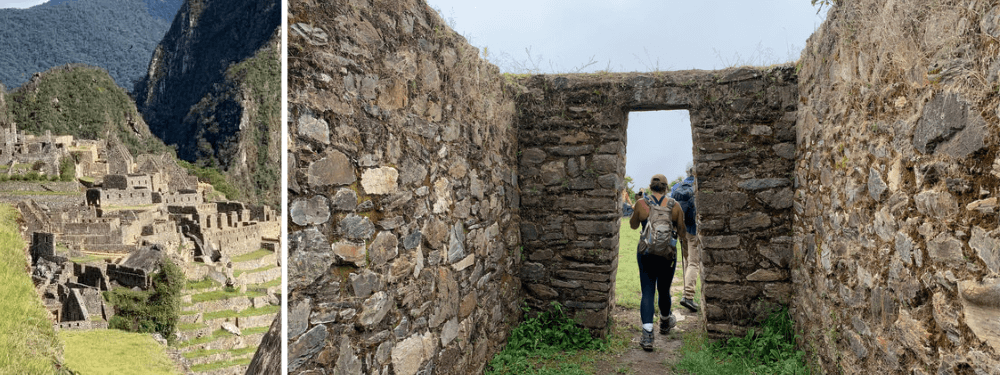
Architecture
Incan architecture is known for its precise masonry. While many of the Incan buildings are made out of fieldstones, adobe, and other materials native to the specific region of the Andes where they were built, the best-known examples feature boulders and stones precisely cut and meticulously shaped to fit closely to one another without the need for mortar. Doors, niches, and windows most commonly had trapezoidal shapes, and though the structures were primarily only one story in height, the buildings sprawled up and down precarious mountainsides creating impressive fortresses.
At the beginning of my last trip to Peru, we were treated to a guided tour of Cusco, where original Inca masonry can still be found in the city. While much of it has been incorporated into Spanish Cathedrals, there are still areas where significant stretches of original Inca works remain intact. Along the trek, we visited several ruins where we could more easily discern how the original works reflected the Quechuans’ cultural heritage: symbols of the sun and moon, terraced hills in sacred areas, altars where tributes were made, and buildings and trapezoid doorways perfectly aligned to point toward sacred mountains and capture the first rays of sunlight on specific days of the year. And, of course, the most stunning example was Machu Picchu itself.
One of the highlights of my trip, which happened during a very quiet moment early on, was when one of our local guides walked me through the process of leaving a sacrifice of coca leaves at one of these ancient sites in the mountains. One aspect of a ritual is that it can transport us outside the realm of time. I felt as though I was very much in the moment and yet experiencing something very ancient simultaneously. I’m excited to share these sites with my partner and explore more ruins in the area, including the Inca Circles of Moray and the Salt Flats of Maras.
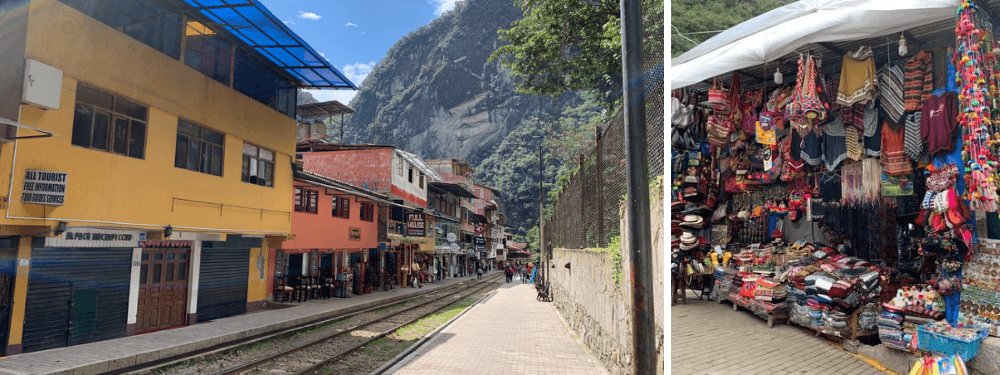
Weaving
Weaving and textiles are another fundamental part of Peruvian and Quechuan history. A great deal of technique goes into creating these finely woven textiles. Wool is gathered from alpacas and other indigenous animals, spun, dyed, and woven into cloth. Bright, saturated reds come from the cochineal, a relative of the aphid found on prickly pear cacti. Rich orange hues come from the bark of plants such as the yanali and chapi plants. Leafy plants like ch’illca create lime and forest greens, while flowers, such as the Q’olle flower, turn into sunny yellows and hues of gold.
These techniques, along with the rich symbols and patterns prominently displayed in Peruvian textiles, are passed down from artisan to artisan, generation to generation. These patterns are intricately woven into the textiles themselves and tell complex stories of the interactions between the people and their natural environment.
With tourism propping up the local economy and many men working as porters and guides, women of the Sacred Valley wondered if they too could find their economic niche. By honing their weaving skills and banding together into textile-producing cooperatives, local female artisans have been able to pass along centuries-old traditions while bringing home an income. Examples of these collectives include the Umasbamba Weaving Community, the Guiding Thread in Chinchero, and the Women’s Weaving Cooperative in Ccaccaccollo.
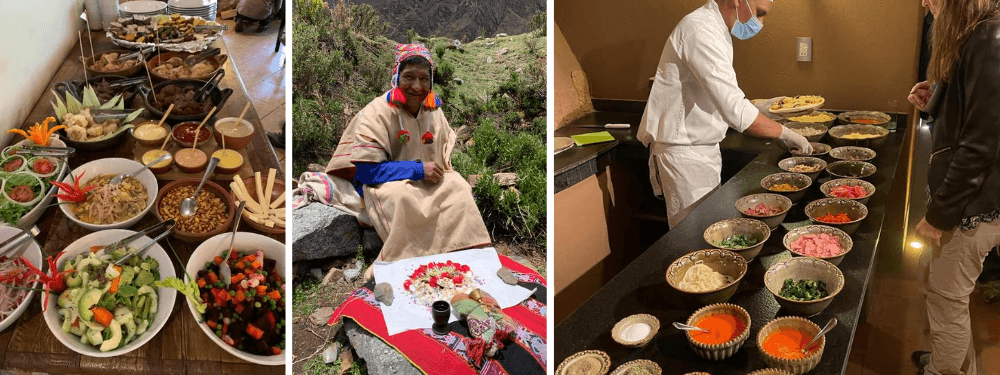
Agriculture and Cuisine
The Sacred Valley has been called the world’s agricultural breadbasket for its agricultural importance. Pictures of the Sacred Valley’s terraced fields have always been beautiful and intriguing, but their significance is quite staggering. While the Andes mountains are rich in fertile soils and water, the geography and elevation of the area provide formidable challenges for farmers. The Incas built sophisticated terraced fields to provide for erosion control, irrigation, and drainage; creating a rich diversity of microclimates for the cultivation of crops. The most prominently grown crops include white potatoes, corn, quinoa, and vegetables. The most vital of these, standing as a proud symbol of the Quechua diet and culture, is the potato. Today Peru boasts over 4,000 potato varieties!
Rituals and ceremonies are fundamental aspects of farming, including offerings to Pachamama, or Mother Earth. On my earlier visit to Peru, we enjoyed an amazing Pachamanca celebration. This is a traditional way of cooking food underground, literally translating as earth (pacha) pot (manca). Pachamanca represents the strong bond indigenous people have with Pachamama. My partner and I both love to cook, and the aspect of shopping in local markets, and trying our hand at preparing Peruvian cuisine while sipping on local teas, is one of the aspects of this adventure we’re looking forward to the most.
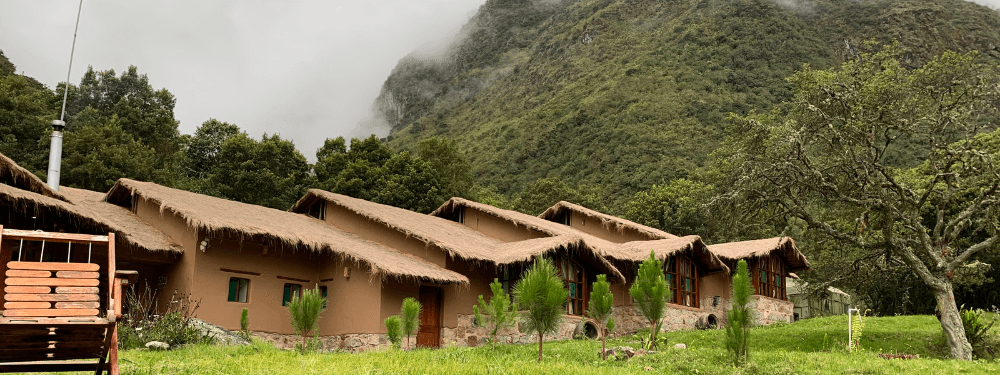
Mountain Lodges of Peru
On our trip, I came to appreciate how closely the operations of the Mountain Lodges of Peru are intertwined with the local communities. Along our route, we stayed in remote mountain lodges whose individual designs had been inspired by the region of each unique setting. At the first lodge, we enjoyed a hot tub that looked straight up at Mount Humantay, the next lodge had an extensive orchid garden, and yet another lodge was nestled alongside a small, family-owned coffee plantation. We were able to visit the family and experiment with roasting and grinding our own coffee. Each lodge was staffed by men and women living in the local villages. One day on trail, we were overtaken by a young masseuse, trekking ahead to meet us at the next location. And the cuisine! The local chefs prepared traditional Peruvian cuisine featuring produce from neighboring farms.
I was extremely fortunate to have shared a portion of that trip with some of the founders of the company. They shared thoughts of what went into the design of each of the lodges and laughter over which of these ideas worked and which, memorably, did not. They tried building one of the lodges out of adobe bricks made from local clay, but they melted with the first rainfalls! The relationships with the local communities are no accident. The founders spent years working on building relationships that would be mutually beneficial over time.
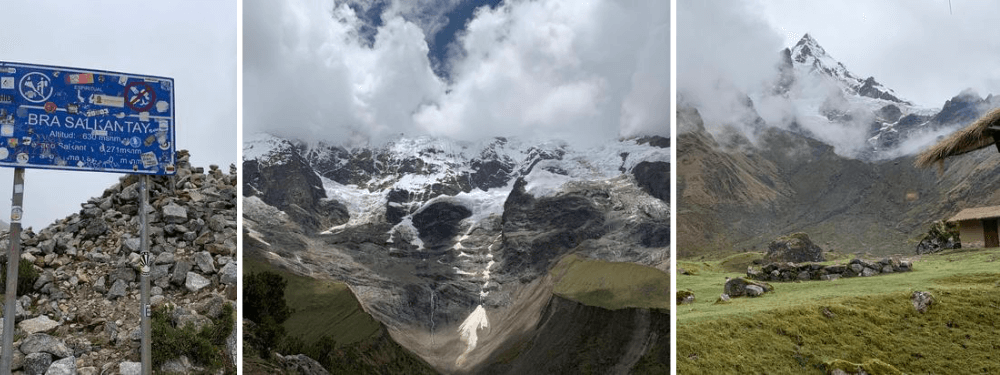
Challenges
Novice travelers that we are, the aspect of traveling so far from home for an extended period is daunting. The language barrier will be our biggest challenge. While I’ve logged some time on both DuoLingo and Rocket Language, I think Google Translate and a pocket dictionary will be my best friends during our three months in Urubamba.
There are many logistical details to work out as well. We’re fortunate to have a local graduate student willing to stay at our house while we're gone. We had contemplated renting our house but ultimately decided we didn’t have the time or inclination to ‘rent-proof’ our home.
We’ll be setting up VPNs (virtual private networks) to protect our internet connections and allow us to access our financial institutions and conduct business while abroad. We’re also opening Wise international money accounts, previously known as TransferWise, to minimize exchange rates. And while my partner’s new phone sports a fancy new virtual e-card, mine does not. I’m considering purchasing a cheap phone when we arrive while leaving my current phone intact for when we have wifi connections.
We’ve created detailed packing lists, trying to minimize luggage needs while accommodating backpacking gear, clothing for multiple occasions, art materials for trying to capture some of these new experiences, and whatever we’ll need to survive for 24 hours before we have the opportunity to visit a market. While we’re a bit anxious not knowing what our kitchen will have supplied, we’ve decided not to bring anything other than a couple of sharp knives and an extra cutting board! We look forward to being creative with what we find.
We’re also learning as much as we can ahead of time about getting around as we’ll be in a small village and won’t have a car. The cheapest and easiest way to get around the Sacred Valley is through colectivos, which are generally 15-passenger vans that provide transportation that falls between a crowded Uber Pool ride and a public bus. They follow specific routes, but you can ask (if you happen to know the language and where you are!) to stop at any point along the way. They don’t have specific schedules, but generally come and go on a regular basis.
We’ve spent a lot of time on Google, but our best sources of information have come from friends and acquaintances, many from this AGC community. If you’ve ever undertaken a similar journey and have advice you’d like to pass along, please send it my way. I’d love to hear it, and I will keep you posted as our journey progresses.
